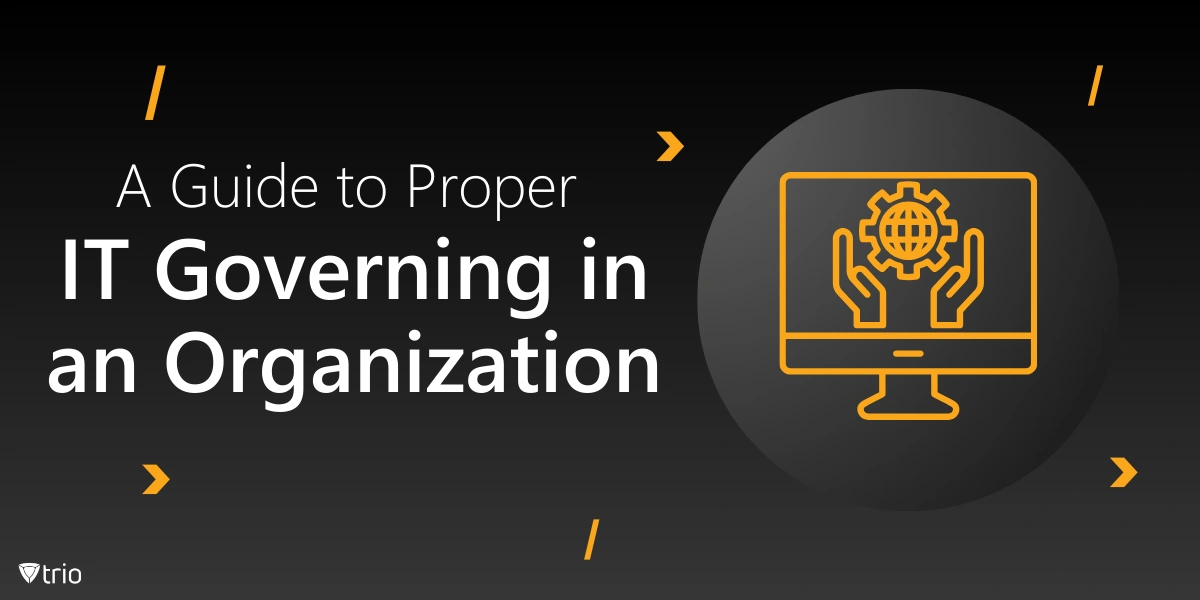In today’s digital age, effective IT governance is crucial for organizations to align their IT operations with business objectives, manage risks, and comply with regulatory requirements. An IT Governance Policy provides a structured framework to guide decision-making, define roles and responsibilities, and ensure that IT supports the overall strategic goals of the organization. In this blog post, we’ll explore the key components of an IT Governance Policy and how it can help your organization maintain a robust and compliant IT governance framework. You can also use our IT governance policy template to get started right away.
Why IT Governance Is Essential
Proper IT governance is essential because it ensures that an organization’s IT resources are aligned with its overall business objectives, effectively managed, and compliant with regulatory requirements. Here’s why it’s so crucial:
-
Alignment with Business Goals
Proper IT governance ensures that IT initiatives are closely aligned with the organization’s strategic goals. This alignment helps maximize the return on IT investments by ensuring that resources are allocated to projects that support business priorities. Without proper governance, IT departments may focus on technology-driven projects that don’t contribute to the organization’s broader objectives, leading to wasted resources and missed opportunities.
-
Risk Management
IT governance provides a structured approach to identifying, assessing, and mitigating risks associated with IT operations. In today’s digital landscape, organizations face numerous IT-related risks, including cybersecurity threats, data breaches, system failures, and compliance issues. A robust IT governance framework helps organizations proactively manage these risks, reducing the likelihood of incidents that could disrupt operations, harm reputation, or result in legal penalties.
-
Regulatory Compliance
Organizations are subject to various laws and regulations that govern how they handle data, maintain security, and manage IT systems. Proper IT governance ensures that the organization remains compliant with these regulations, which can include industry-specific standards like GDPR, HIPAA, or SOX. Non-compliance can lead to severe consequences, including fines, legal action, and loss of customer trust. IT governance helps ensure that all IT processes and practices are aligned with regulatory requirements. ISACA favors an effective IT governance framework for a variety of reasons, including implementing due diligence or in other words, regulatory compliance and transparency.
-
Accountability and Transparency
IT governance establishes clear roles, responsibilities, and decision-making processes, promoting accountability within the organization. This clarity ensures that all stakeholders understand their responsibilities and that decisions are made transparently and based on well-defined criteria. It also helps prevent issues like shadow IT, where employees deploy unapproved technologies, which can lead to security vulnerabilities and compliance risks.
-
Cost Management and Efficiency
An effective IT governance model helps organizations manage their IT budgets more efficiently by prioritizing investments in technologies and projects that deliver the most value. It also helps avoid unnecessary expenditures by eliminating redundant systems and streamlining processes. By focusing on value-driven IT initiatives, organizations can achieve better cost control and operational efficiency.
-
Improved Decision-Making
IT governance provides a structured framework for decision-making, ensuring that IT decisions are made based on objective criteria and aligned with the organization’s strategic goals. This improves the quality of decisions, as they are informed by data, risk assessments, and business priorities. It also speeds up decision-making by reducing the ambiguity and inconsistency that can occur in the absence of a formal governance process.
-
Enhancing Organizational Agility
With proper IT governance, organizations can respond more quickly to changes in the business environment or technological landscape. Governance frameworks often include processes for evaluating and adopting new technologies, allowing organizations to stay competitive and innovative while managing the associated risks. This agility is crucial in industries where rapid technological advancements or market shifts can significantly impact business success.
-
Building Stakeholder Confidence
Investors, customers, and other stakeholders increasingly expect organizations to have robust IT governance practices in place. Demonstrating effective IT governance can build confidence among stakeholders by showing that the organization is committed to managing its IT resources responsibly, protecting sensitive data, and complying with regulations. This trust can be a competitive advantage, particularly in industries where data security and regulatory compliance are critical.
Key Components of an IT Governance Policy
Some key components that an IT governance policy should include are as follows.
-
Roles and Responsibilities
A clear definition of roles and responsibilities is critical for effective IT governance. The IT Governance Policy should outline the formation of an IT Governance Committee, the role of the CIO, the responsibilities of IT Managers, and the expectations for all employees. This ensures accountability and promotes a culture of governance across the organization.
-
Decision-Making Processes
Your IT Governance Policy should establish structured decision-making processes for both strategic and operational IT decisions. This includes guidelines for IT budgeting, project approvals, and escalation protocols for significant operational issues. A well-defined decision-making process helps prevent miscommunication, ensures that decisions are aligned with business objectives, and reduces the likelihood of governance failures.
-
Risk Management
Effective risk management is a cornerstone of IT governance. Your policy should include a comprehensive IT risk management framework that covers risk identification, assessment, mitigation, and monitoring. It should also define incident response procedures to ensure the organization can quickly and effectively respond to IT incidents, minimizing their impact on operations.
-
Compliance with Regulatory Requirements
Compliance is a critical aspect of IT governance. The policy should include a regulatory compliance framework that ensures all IT activities meet legal and regulatory standards. This includes regular monitoring, documentation, and preparation for audits. Keeping your IT operations compliant not only protects your organization from legal issues but also builds trust with customers and stakeholders.
-
Training and Awareness
IT governance is only effective if all employees understand their roles and responsibilities. The policy should include training programs for new hires and ongoing training for all employees. Additionally, awareness campaigns can help promote a culture of IT governance, ensuring that governance practices are embedded in daily operations.
Free IT Governance Policy Template
IT governance is not a one-time effort; it requires ongoing evaluation and improvement. Your IT Governance Policy should include provisions for continuous performance monitoring and policy enhancement. Regular reviews and updates ensure that the policy remains aligned with the evolving needs of the organization and changes in the regulatory landscape.
An effective IT Governance Policy is essential for any organization that wants to ensure its IT operations align with business goals, manage risks effectively, and comply with regulations.
By using the IT Governance Policy Template provided, your organization can establish a clear and structured framework for IT governance that promotes accountability, mitigates risks, and supports strategic objectives.
To further enhance your organization’s IT governance efforts, consider leveraging Trio’s advanced Mobile Device Management solution that offer robust governance and compliance tools tailored to your business needs. Start your free trial today and take the first step toward building a more secure and compliant IT environment.
Get Ahead of the Curve
Every organization today needs a solution to automate time-consuming tasks and strengthen security.
Without the right tools, manual processes drain resources and leave gaps in protection. Trio MDM is designed to solve this problem, automating key tasks, boosting security, and ensuring compliance with ease.
Don't let inefficiencies hold you back. Learn how Trio MDM can revolutionize your IT operations or request a free trial today!




